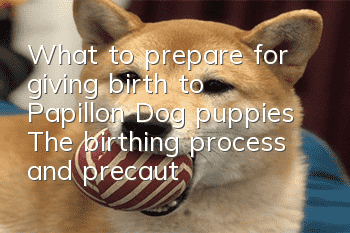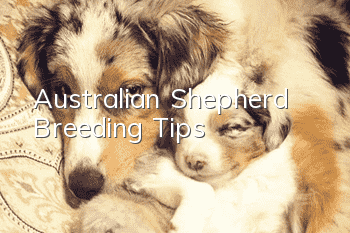What to prepare for giving birth to Papillon Dog puppies? The birthing process and precautions of Papillon female dogs

Parents who have raised female dogs should have experienced the process of dog littering. Not only do you need to prepare a lot of things before littering, but you also need to pay attention to many nutrition and care-related precautions during littering. Here is a brief introduction to you. The process of pre-puppying and separation of Papillon dogs:
1) Prenatal preparation
A few days before the expected date of delivery, the pregnant Papillon female dog will automatically look for hidden places such as the corner of the house or under the shed, pick up grass and build a nest. This is an instinct of the female dog, indicating that she will give birth soon. At this time, people You should start preparing your dog for delivery. Specifically, the following work must be done.
1. Keep good hygiene
The delivery room should be thoroughly cleaned, mattresses should be replaced, and 0.5% Lysol or other disinfectants should be sprayed and disinfected to maintain air circulation. The whole body of the female dog should be washed, especially the buttocks and breasts, which can be cleaned with 0.1% Xinjierzao solution.
2. Make a birth box
The farrowing box can be made of wooden boards, and its height should not allow the puppies to escape. In order to make it easier for the puppies to enter and exit, there should be a gap on one side of the birth box, and some thin wooden strips with small gaps should be laid on the bottom, and soft short grass or old blankets, rags, etc. should be laid on top (see Figure 5-1). The inner wall of the birthing box must be smooth without sharp protrusions to prevent scratching the puppies. The farrowing box should be placed on bricks or wooden blocks to facilitate ventilation and keep the box dry.
3. Prepare delivery equipment
Such as scissors, sterilized gauze, cotton balls, 70% alcohol, 5% iodine, 0.5% Lysol, 0.1% Xinjiazil, etc.
(2) Signs of labor
The body temperature of female dogs begins to drop about 3 days before delivery. The normal rectal temperature is 38~39℃, and it will drop by 0.5~1.5℃ before delivery. When the body temperature starts to rise, it indicates that labor is about to begin. The female dog's breasts will swell and the mammary glands will be full within 2 weeks before delivery. A small amount of milk can be squeezed out from the nipples 2 days before delivery. A few days before delivery, the vulva gradually becomes soft, swollen, and congested, the folds on the labia skin expand, and the vaginal mucosa becomes flushed. 24 to 36 hours before delivery, the female dog's appetite is greatly reduced, or even stops eating. She acts impatiently and often scratches the ground with her claws. This is especially true for first-time female dogs. 3 to 10 hours before delivery, the female dog begins to have labor pains, is restless, often yawns, moans or screams, scratches the bedding, has shortness of breath, increases the frequency of urination, obvious collapse of the ischial tuberosity of the buttocks, and swelling of the vulva. , if you see mucus flowing out, it means you will give birth within a few hours. Usually delivery occurs in the early morning or evening, and special attention should be paid to observation during these two periods.
(3) Childbirth process
The length of delivery varies depending on the number of litters and the physical condition of the female dog. Generally 3~4 hours, the interval between birth of each fetus is 10 to 30 minutes. Under normal circumstances, female dogs will instinctively handle everything without the need for special care, especially for native breed dogs. However, some precious toy dogs or purebred dogs have poor instincts and need help from people. Therefore, during childbirth, someone needs to watch by and deal with problems in time.
When giving birth, female dogs often lie on their sides, look back at their abdomen, complain, moan, and breathe faster, and then extend their hind legs. At this time, thin liquid flows out from the vulva, and then the first fetus with fetal membranes is delivered. The dog will quickly tear the fetal membranes with its teeth, bite off the umbilical cord, and lick up the mucus on the fetus. If the first fetus can be delivered successfully, other fetuses generally will not have dystocia.
Dogs are multi-pregnant animals. The number of litters per litter is generally 6 to 9, ranging from 1 to 2 to 16, with the highest record being 25. To determine whether the labor is over, generally the female dog becomes quiet after giving birth to several fetuses, constantly licks the coat of the puppies, and does not see her licking again after 2 to 3 hours, which means that the labor is over. But there are also a few who give birth again after a few hours.
Things to note when giving birth:
First, the place where the dog gives birth should be dark and not bright, so as to avoid the excitement of the female dog. There should be no noise around, and it is strictly forbidden for many people to watch, otherwise the bitch will be overly nervous and cause dystocia.
Second, pay attention to the action of biting off the umbilical cord by the female dog. If you find that the female dog is "eating cubs", you should stop it in time.
Third, it is normal for female dogs to eat the placenta after giving birth. It has a lactation effect, but eating too much can cause gastrointestinal digestive disorders. Generally, you can eat 2 to 3 pieces.
Fourth, when a pregnant dog has been leaking a large amount of thin liquid from the vagina for several hours, or when the fetus cannot be fully delivered after 10 minutes of exposure to the vagina, it means that the female dog has dystocia. At this time, assisted delivery or caesarean section is required.
Fifth, after delivery, if there is still a lot of bright red excrement flowing out of the vagina, it indicates that there may be heavy bleeding in the birth canal. The vagina should be blocked with absorbent cotton immediately and sent to a veterinary clinic for treatment.
(4) Midwifery
When the female dog is physically weak and it is difficult for the fetus to deliver normally, artificial midwifery is required. Midwives should wash their hands and disinfect them with alcohol cotton or 0.1% Xinjier disinfectant. If the midwife has injuries on her hands, she should wear latex gloves to prevent infection.
The specific method of midwifery is: hold the part of the fetus exposed to the vagina with your hands, gently return the fetus during the interval between the mother dog's efforts, and slightly rotate the position, and then carefully pull it outward while the mother dog exerts her strength. , the movements should be gentle and steady. Under normal circumstances, the fetus can be delivered successfully.
After the fetus is delivered, quickly tear the fetal membranes and wipe them with gauzeRemove mucus from the nose and mouth to prevent fetal suffocation. If the female dog’s umbilical cord is not cut off, the root of the umbilical cord can be tied with a thread, cut 2 cm away from the belly button, and then apply 5% iodine on the broken end to prevent infection. Then put the fetus to the female dog's mouth and let her lick it dry. If the fetus is suffocated or suspended in suspended animation due to the entry of amniotic fluid into its respiratory tract, the fetus should be lifted upside down and patted gently to drain the amniotic fluid and wipe away the mucus in the nostrils. If it still cannot breathe, artificial respiration should be performed.
(5) Postpartum care
First, after the female dog has given birth, the dirt on her vulva, tail, breasts and other parts should be washed with warm water, contaminated bedding should be replaced, and the delivery room should be kept warm and moisture-proof.
Second, you should always pay attention to the mother dog squeezing the puppies. If you hear the short barking of the puppies, you should check immediately and take out the squeezed puppies.
Third, strangers are not allowed to visit, and do not touch or catch the puppies with your hands to prevent the mother dog from eating the puppies due to the smell.
Fourth, female dogs generally do not eat within 6 hours after giving birth. They always rest in the nest except for defecation and defecation. At this time, they can be given warm water to drink. Within 2 to 3 days after giving birth, the female dog has poor appetite and should be fed more high-quality but small-quantity food every day.
Fifth, although the newly born puppies have their eyes closed, they can find nipples by smell and touch and start sucking milk. Weak puppies should be placed next to the milk-rich nipples with artificial assistance. Pay attention to the lactation condition of the female dog. If the female dog does not return to the birthing box for a long time after giving birth or the puppies move or bark for a long time, it may be a sign that the female dog is not lactating or is sick. Artificial lactation or lactation should be considered.
Sixth, it is necessary to do a good job in preventing freezing and keeping warm the puppies in winter. Bedding, litter, and cold-proof curtains can be hung at the door of the kennel, etc. If the temperature of the kennel is too low, infrared heaters or infrared lamps can also be used for heating. If the puppies are piled together to keep each other warm, it means the temperature is low. If the puppy is far away from the heater, it means the temperature is too high. Accordingly, the appropriate temperature required for the delivery of puppies can be adjusted.
- What should you pay attention to when caring for your Husky’s teeth? Things to note when caring for your Husky’s teeth!
- What is the temperament of the West Highland White Terrier? Is it easy to raise? | Pictures | Price
- What should you pay attention to when buying a Chihuahua? What are the criteria for selecting a Chihuahua?
- Here’s a breakdown of the top ten causes of death for pets, parents should be careful!
- How do you identify your ideal Papillon?
- What is the cause of blood in dog urine? What medicine should I take?
- Dog vomited yellow thick stuff
- Dog keeps urinating but can’t urinate
- How to get rid of mites on dogs?
- How to train a dog to be obedient? Dog training tips!



